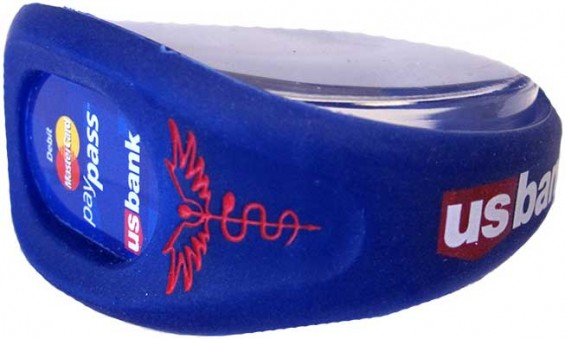Those who follow the broader retail banking industry will know that many of the most exciting developments occur in the payments space — chip-and-PIN, mobile payments and P2P, for example. Everyone is scrambling to stake their claim in the new digital payments frontier. US Bank is the latest contender to throw its hat into the payments innovation ring with VITAband, a light-weight and durable wristband that combines contactless payment technology with emergency contact and medical information. You could call it a “pay bracelet” or “wearable wallet.”
The VITAband allows customers to simply “tap and go” when making purchases at merchants that accept contactless payments on MasterCard’s PayPass platform. Signatures are not required for purchases under $50.
The US Bank MasterCard PayPass VITAband contains a Radio Frequency Identification (RFID) payment chip, the technology that enables contactless purchases. Each band also carries a VITAnumber, a unique, 8-digit numeric identifier that links the user to a customizable Emergency Response Profile, where first responders can find the wearer’s identity and critical medical information in the event of an emergency.
Through an online VITAband account, users can check their balance, reload their prepaid wristband and customize their emergency medical profile. Because the VITAband works like a prepaid card, users can limit the amount available to thieves should the pay bracelet be lost of stolen. But if your VITAband falls into the wrong hands, there’s not much you can do to stop them from draining whatever money was loaded on it.
The VITAband has an initial fee of $39.95 which includes a one year subscription to the storage of medical records and emergency contacts. After the first year the service costs $19.95 per year. Replacement bands cost $19.95.

How Banks Are Fortifying Their Data Against Increasing Cyber Threats
This webinar from Veeam will detail the value of working together across your organization to be better prepared in cyber defense and response readiness.
Read More about How Banks Are Fortifying Their Data Against Increasing Cyber Threats

Send the Right Offers to the Right Consumers
Achieve a better return on your marketing investment. Leverage behavioral data and analytics to target the right customers with the best possible offers.
Read More about Send the Right Offers to the Right Consumers
“US Bank MasterCard PayPass VITAband is great for sports enthusiasts or people who are on-the-go and don’t want the hassle of carrying cash and identification,” said Beth Blaisdell, SVP/US Bank Payment Services.
“Combining the speed and convenience of contactless payments technology with a high-tech medical ID bracelet, it is the perfect companion for those with an active lifestyle,” added Mario Shiliashki, SVP/US Bank Emerging Payments.
US Bank became one of the first major card issuers in North America to pilot this new technology when its employees began testing the VITAband in multiple states in the second quarter of 2011.
To develop this new product, US Bank needed to partner with MasterCard for contactless payments, Vita Products who manufactures the VITAband, smart card company Oberthur Technologies and FIS to handle the transactions.
Analysis
US Bank is essentially asking people to strap a second wrist watch to their body, because the VITAband doesn’t even tell time (how much could it have cost to add that feature?). Functionally, the VITAband only does two things — convenience with small payments and emergency medical info. The size of target market for such a bizarre combination of features has to be less than a fraction of a sliver.
Regardless of what you may think of the concept, there is one facet of the VITAband that is hard to deny: it is ugly. It’s one thing to ask consumers to tuck a bland credit card in their wallets. It’s another to think folks will wear an unattractive, bulky band of blue splashed with bank logos. It looks like those cheap digital watches from 1985. With the VITAband so lacking in style, US Bank has forgotten that “fashion” trumps “functionality” when it comes to clothing and accessories.
As Jim Bruene, publisher of NetBanker, put it: “Nice gimmick, but really? Who would wear a bank-branded bracelet for contactless payments?”
The only way VITAband has a shot at survival is if US Bank offers more stylish alternatives. Even then…
It seems the best VITAband can hope for is to serve as a “bridge technology,” something that gets consumers accustomed to the concept of contactless payments. Ultimately, everything consumers need — payment instruments, medical information, songs, movies, etc. — will be housed on their smart phones. There is no room left — in the marketplace or on our bodies — for more unnecessary or redundant gadgets.
Think about it. Who needs a watch when you’ve always got your phone? Same thing for iPods? And wallets are getting thinner. Cash is going away. Checks are nearly extinct. We’re lightening the load by going digital, and consolidating functions on a single device. In a world where we are carrying less stuff — not more — the VITAband feels like one more burden, one more thing to carry around, one more thing you can lose.








